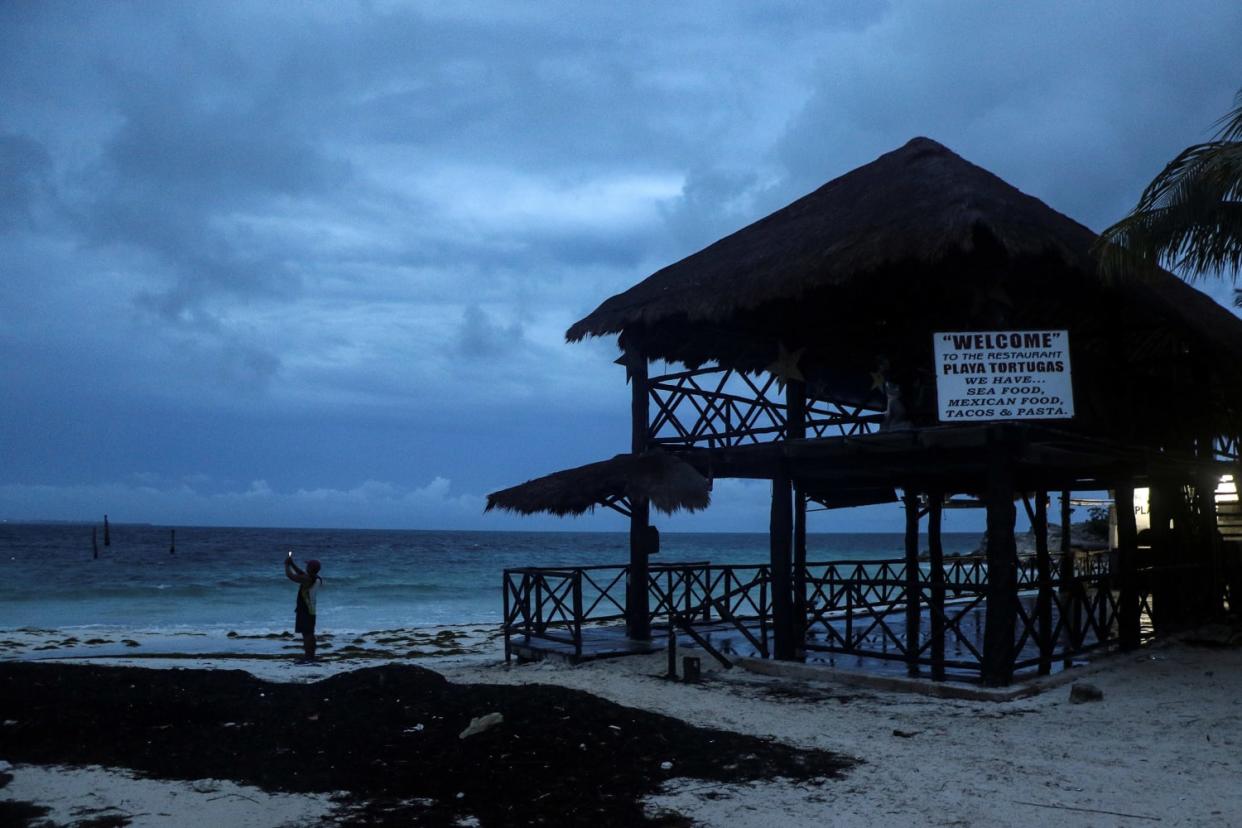Hurricane Delta makes landfall on Yucatan Peninsula, heads toward Gulf Coast
Hurricane Delta made landfall early Wednesday along the Yucatan Peninsula, packing winds estimated at 110 mph, toppling trees and cutting electricity to parts of the tourist meccas of Cancún and Cozumel.
The storm, which made landfall about 23 miles south of Cancún around Puerto Morales, was forecast to bring a life-threatening storm surge that would raise water levels in some areas as much as 8 to 12 feet above normal tide.
As of midday Wednesday, there were no reports of deaths or injuries in Mexico from the storm.
By 11 a.m. ET, Delta had slightly weakened to maximum sustained winds of 105 mph. But, it is forecast to strengthen again to a Category 4 by Thursday evening as it gains steam from the warm waters of the Gulf of Mexico.
Forecasters said the storm's eye is expected to move from Yucatan to the Gulf around midday Wednesday.
Delta will next steam toward U.S. coast
The National Hurricane Center issued a hurricane watch for the Gulf Coast between High Island, Texas, and Grand Isle, Louisiana, and a tropical storm watch for areas further west and east, including New Orleans and Lake Ponchartrain.
Tropical force winds could begin in U.S. Gulf Coast communities by Thursday night, and on Friday there is an increasing likelihood of a life-threatening storm surge and dangerous hurricane-force winds, especially along the coasts of Louisiana and Mississippi.
Delta is expected to make landfall along the central Gulf Coast late Friday or very early Saturday morning.
States of emergency declared in Alabama, Louisiana
Ahead of Delta's forecast arrival, the governors of Alabama and Louisiana declared states of emergency.
Alabama Gov. Kay Ivey issued a mandatory evacuation order for all tourists and visitors to its coastal communities of Orange Beach, Gulf Shores and Dauphin Island, as well as the unincorporated areas of Ono Island and Fort Morgan, a string of delicate barrier islands that stretch between Florida and Mississippi.
In an announcement of Alabama's state of emergency, Ivey said her state is still recovering from Hurricane Sally and said workers doing cleanup should remain on the job "as long as possible"
"We want to stay focused on our current cleanup and recovery from Sally for as long as possible even as we make preparations for Hurricane Delta," Ivey explained Tuesday.
In a statement with his disaster declaration, Louisiana Gov. Jon Bel Edwards called Delta "an incredibly dangerous storm that will bring heavy winds, rain and life threatening flooding and storm surge to coastal Louisiana."
“All of Louisiana’s coast is in the tracking cone, and we are well aware that impacts can be felt outside of the track," Bel Edwards said, advising south Louisiana residents to pay close attention to weather reports and heed the orders of emergency response officials.
Louisiana is still recovering from Hurricane Laura, which struck its coast in August as a Category 4 storm. Over 6,000 Laura evacuees remain in hotels, mainly in New Orleans, due to damage to their homes.
Also in anticipation of the storm on Tuesday, the National Park Service pre-emptively closed Jean Lafitte National Historical Park and Preserve in southern Louisiana, an expansive wetlands area that sits close to sea level.
Delta will be the 10th hurricane landfall on the mainland U.S. this season, setting a new record for the number of landfalls in a single season.

Tourists hunkered down
Prior to its landfall in Mexico at about 6:30 a.m. ET, Delta increased in strength by 80 mph in just 24 hours, more than doubling from a 60 mph storm.
Its top winds peaked at 145 mph before weakening slightly late Tuesday as it closed in on Yucatan.
"Conditions are going downhill fast for northeastern Yucatan, while storm surge and hurricane watches will be issued later today for parts of the United States Gulf Coast," the National Hurricane Center said at 4 a.m. ET as the storm approached the area.
The governor of the Mexican state of Quintana Roo, Carlos Joaquín, said the government had prepared, but he warned residents and tourists that “it is a strong, powerful hurricane.” He considered it a good sign that Delta had weakened a bit late Tuesday, but said the area hadn’t seen a storm like it since Hurricane Wilma in 2005.
Thousands of Quintana Roo residents and tourists hunkered down in dozens of government shelters, waiting for landfall. Everyone had been ordered off the streets by 7 p.m.
Throughout Tuesday, the evacuations of low lying areas, islands and the coastline expanded as Delta exploded over the warm Caribbean waters offshore. Much of Cancun’s hotel zone was cleared out as guests were bused to inland shelters. In Cancun alone, the government opened 160 shelters.
Some 300 guests and nearly 200 staff from the Fiesta Americana Condesa hotel were taken to the Technological Institute of Cancun campus. All wearing masks, they spread out on thin mattresses in a classroom building and tried to get comfortable as workers boarded up the building’s windows in a light rain. Some played cards or watched videos on their phones, while others called relatives.
“The hotel has done a good job of making sure that we were provided for and that we’re going to be safe here in this place, so we don’t have any concerns at all,” said Shawn Sims, a tourist from Dallas sheltering with his wife, Rashonda Cooper, and their sons, 7-year-old Liam and 4-year-old Easton.
“This is my first (hurricane) experience, but I see that these guys have a plan and they know what they’re doing,” Sims said.
This is a developing story; please check back for updates.
